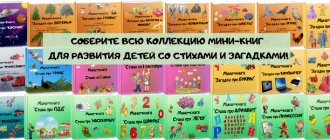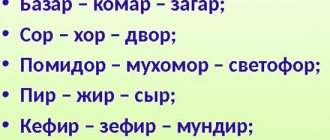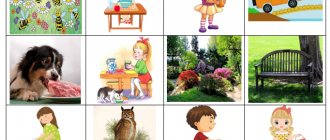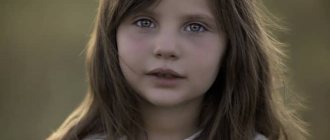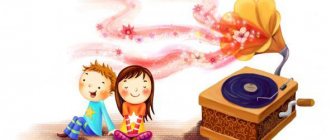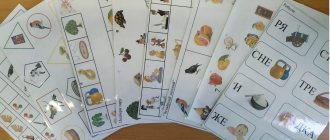Visual and didactic manual on sound automation [C] “Interesting cards”
Galina Kostyuk
Visual and didactic manual on sound automation [C] “Interesting cards”
Automation of assigned sounds is a very important and responsible stage in correctional and speech therapy work to eliminate sound pronunciation disorders. For many children, unfortunately, for various reasons, sounds are very difficult to automate. The use of visualization in correctional work contributes to the formation of children’s interest in classes, and gaming techniques stimulate the mental activity of speech-language pathologist children, thereby contributing to the achievement of the desired results.
I made this manual using the picture designer from the Mersibo development portal. It consists of 4 cards of A-4 format. On the front side there is a house and pictures that “live” in this house. On the reverse side there is a description of the game exercises used in working with this manual. I selected the pictures in such a way that the words did not contain hissing sounds and a minimum of sonorities. Speech therapists and speech pathologists know that this fact contributes to a more successful process of automating whistling sounds.
Visual and didactic aid “Interesting cards”. Automation of sound C.
Target:
Automation of the sound C in words, in sentences; development of phonemic perception, grammatical structure, coherent speech.
Card No. 1 Automation of the sound C at the beginning of a word.
Game exercises:
“Repeaters” The child repeats the names of the pictures after the adult (sun, plane, dog, salad, owl, fireworks, scoop, saxophone, boots, nightingale, catfish, salt shaker, elephant, pig, soup, bough, chest, juice, table, chair, glass, beets, plums).
“Name the object and get a chip” The child names the pictures independently and receives a chip for pronouncing the word correctly.
“Hide and seek” The child closes his eyes, the adult covers several pictures with chips. The child opens his eyes and names the pictures that are “hidden.”
“Name the furniture” (transport, pets, greenery, birds, etc.)
"Who has a tail?" Child: The dog has a tail, etc.
“One is many” 1st child (or adult) - airplane, 2nd child - airplanes, etc.
“What words live in the house?” The adult closes the card, the child names the words that he remembers.
“Telegraph” The child divides words into syllables (claps, taps, lays out with chips).
“Continue the sentence” The adult says the beginning of the sentence, the child finishes. For example: (an airplane is flying high in the sky). Delicious (juice) was poured into a glass. An empty glass was placed on the table, etc.
“What is between, what is” The child makes sentences according to the model: The plane is between the sun and the dog, etc.
“I don’t have something, but I have something” 1st child (or adult) - I have the sun. 2nd child - I don’t have the sun, but I have a plane, etc.
“Make a sentence according to the model” Sample: The owl sleeps during the day, and the nightingale sings, etc.
Card No. 2 Automation of the sound C in the middle of a word
Game exercises:
“Acquaintance” The adult invites the child to get to know the “residents” of the house and determine the common sound in all words, as well as the place of the sound in the words, paying attention to the color of the roof, the letter and the windows.
“Repeat” The child repeats the names of the pictures after the adult (fox, wasp, braids, beans, wheel, mustache, watch, dishes, beads, braid, sand, donkey, swallow, wasps, stork, popsicle, leaf, bridge, football player, cabbage, wheels).
“Name the object and get a chip” The child names the pictures independently and receives a chip for pronouncing the word correctly.
“Name the animals” (birds, insects, garden tools, etc.)
"Who has a tail?" Child: The fox has a tail, etc.
“One is many” 1st child (or adult) is a wasp, 2nd child is a wasp, etc.
“What words live in the house?” The adult closes the card, the child names the words that he remembers.
“Telegraph” The child divides words into syllables (claps, taps, lays out with chips).
“Continue the sentence” The adult says the beginning of the sentence, the child finishes. For example: We saw a cheat (fox) in the forest. Sonya put on her favorite (beads), etc.
“What is between, what is” The child makes sentences according to the model: The wasp is between the fox and the braids, etc.
“I don’t have something, but I have something” 1st child (or adult) - I have a fox. 2nd child - I don’t have a fox, but I have a wasp, etc. “How many wasps (braids?” Child - five wasps, three braids.
“Pick a rhyme” Adult – fox, child – scythe, wasp, etc.
Card No. 3 Automation of the sound C at the end of a word
Gaming techniques:
“Acquaintance” The adult invites the child to get to know the “residents” of the house and determine the common sound in all words, as well as the place of the sound in the words, paying attention to the color of the roof, the letter and the windows.
“Repeaters” The child repeats the names of the pictures after the adult (bus, globe, forest, plus, tray, nose, belt, pineapple, canopy, compass, coconut, oats, vacuum cleaner, ear, focus, ficus, duchess).
“Name the object and get a chip” The child names the pictures independently and receives a chip for pronouncing the word correctly.
“Hide and seek” The child closes his eyes, the adult covers several pictures with chips. The child opens his eyes and names the pictures that are “hidden.”
“Name the transport” (fruits, plants, etc.)
“One is many” 1st child (or adult) - bus, 2nd child - buses, etc.
“What words live in the house?” The adult closes the card, the child names the words that he remembers.
“Telegraph” The child divides words into syllables (claps, taps, lays out with chips).
“Make a sentence” The adult names a word, the child makes a sentence with this word.
“What is between, what is” The child makes sentences according to the model: The globe is between the bus and the forest, etc.
“I don’t have something, but I have something” 1st child (or adult) - I have a bus. 2nd child - I don’t have a bus, but I have a globe, etc.
“Pick a rhyme” Adult – bus, child – globe (tray – coconut, nose, oats, vacuum cleaner), etc.
Card No. 4 Automation of sound C at the beginning, in the middle, at the end of a word
Gaming techniques:
“Repeaters” The child repeats the names of the pictures after the adult (pineapple, stork, clock, plane, wasp, popsicle, juice, tray, dishes, bus, catfish, owl, boots, wheel, dog, pig, forest).
“Name the object and get a chip” The child names the pictures independently and receives a chip for pronouncing the word correctly.
“Hide and seek” The child closes his eyes, the adult covers several pictures with chips. The child opens his eyes and names the pictures that are “hidden.”
“Name the words in which the sound C is at the beginning” (in the middle, at the end)
“Name the transport” (fruits, plants, birds, insects, pets, shoes, etc.)
“One is many” 1st child (or adult) - pineapple, 2nd child - pineapples, etc.
“Telegraph” The child divides words into syllables (claps, taps, lays out with chips).
“Continue the sentence” The adult says the beginning of the sentence, the child finishes using the words from the card. For example: (an airplane is flying high in the sky). Orange juice was poured into (a glass).
“Make a sentence” The adult names a word, the child makes a sentence with this word.
“What is between, what is” The child makes sentences according to the model: The stork is between the pineapple and the clock, etc.
“I don’t have something, but I have something” 1st child (or adult) - I have a pineapple. 2nd child - I don’t have a pineapple, but I have a stork, etc.
“Make sentences based on the model” Sample: The stork flies and the catfish swims. The dog barks and the pig grunts.
Children are happy to study using these cards, they are interested, hence the name “Interesting Cards”.
Sound automation [C]
- Speech therapist.No
- Automation of sounds
- Automation of sound C
Audio automation exercises [C]. C__ - long pronunciation of the sound [C].
1) Pronounce (read) the syllables S__A, S__O, S__U, S__Y, S__E
The sound [S] is pronounced for a long time
2) Pronounce (read) words with the sound [C] at the beginning
Sample: s-oh
|
|
|
|
3) Pronounce (read) words with the sound [C] in the middle
Sample: kos-a
|
|
|
|
4) Pronounce (read) the syllables AC__, OS__, US__, YS__, ES__, IS__, ES__, YS__, YS__, YS__
The sound [S] is pronounced for a long time
5) Pronounce (read) words with the sound [C] at the end
Sample: us__.
|
|
|
|
6) Pronounce (read) words with a combination of consonants with the sound [C] in the middle
Sample: dis__k.
|
|
|
|
|
7) Pronounce (read) words with a combination of consonants with the sound [C] at the beginning
Sample: с__lon.
|
|
|
|
 Pronounce (read) phrases
Pronounce (read) phrases
- Salted butter.
- Salted cabbage.
- Sweet watermelon.
- Sweet and sour kvass.
- Ripe apricot.
- Radish salad.
- Sausage with garlic.
- Bowl of rice.
- Tall birch tree.
- Dense forests.
- Empty barn.
- Motley dog.
- Old suit.
- Narrow boots.
- Clean dishes.
- Tasty soup.
- Sonya is tired.
- Glory in the bushes.
- Sanya fell asleep.
- Larisa has a stroller.
- Rash the sand, Nastya.
9) Conjugate sentences
- I cut down a pine tree.
- I put the soup on the table.
- I ate a glass of sour cream.
- I broke a branch from a bush.
Sample:
- I slept on the sofa.
- You slept on the sofa.
- He (she) slept on the sofa.
- We slept on the sofa.
- You slept on the sofa.
- They slept on the sofa.
10) Say (read) sentences
Sample: S_they have a smart mind.
- There is a fox in the forest.
- A wasp sits on the sedge.
- There are dishes on the shelf.
- There are tall pines in the forest.
- Stas has blond hair.
- Carry the sand with a shovel.
- Dogs don't bite their own.
- I fell from the sled into the bushes.
- There are staunch soldiers on the desk.
- The ship stopped at a rock.
- The plane flies high above the forest.
- The dog sees an owl on the bitch and barks.
- Sedge dries in the sun.
- Bring dry straw for the donkey.
- There are sweet plums in the garden.
- It's damp outside, put on your boots.
- Sonya, look - catfish!
- The catfish has a mustache.
- In the buffet there is cod, sugar, cheese, lard.
- Sonya brushed the salt off the table.
- Stas eats sausage with garlic.
- The moose broke a pine branch.
- Your kvass is delicious.
- Slava ate the whole pineapple.
- Someone squeaked in the bushes.
11) Pronounce (read) tongue twisters
- Sonya and Sanya have a catfish with a mustache in their nets.
- Haymaking, haymaking, meadow was left without hair.
- A well-fed elephant sleeps peacefully, enjoying its hundredth dream.
- Fall, snow, snow, sprinkle everyone, everyone!
- Elephants are calm and strong.
- I bring soup, soup, and to whom, to the dog, to the dog.
- Little Sanya's sleigh moves on its own.
- Slava ate lard, but there was not enough lard.
- Gander after gander stomp in single file, gander looks down on gander.
- Osa is barefoot and without a belt.
12) Pronounce (read) and retell the text
In the forest
Sanya and Slava were in a pine forest. There was a dog with them. The forest is damp and there is little sun. The dog saw a magpie on the bitch. The magpie saw the dog and flew away. Sanya saw a hedgehog under the pine tree. Sanya failed to catch him. Slava stood up and began to look up. An airplane was flying over the forest. The plane scared the fox. A fox ran past the boys into a hole. Then Sanya and Slava turned home. At the edge of the forest, grass was drying in stacks. The guys rested by the haystack. Soon they were home.
13) Say (read) poems
Sledging
Sanya and Sonya are riding on a sled, pushing the sled. Sleigh jumps, Sanya hits the side, Sonya crashes into a snowdrift.
Ganders
They walk along the line, gander after gander. The gander looks down on the gander. Oh, the Gusak will pluck the gander's sides.
14) Pronounce (read) and memorize a poem
Dream
Sonya, Sanya, the dog and the cat are sleeping peacefully, the catfish with its mustache is falling asleep, the owls are sleeping on the bough.

